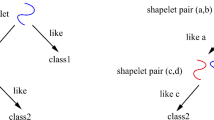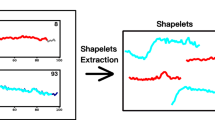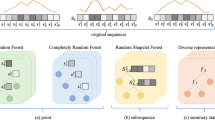Abstract
Early classification of time series has emerged as an increasingly important and challenging problem within signal processing, especially in domains where timely decisions are critical, such as medical diagnosis in health-care. Shapelets, i.e., discriminative sub-sequences, have been proposed for time series classification as a means to capture local and phase independent information. Recently, forests of randomized shapelet trees have been shown to produce state-of-the-art predictive performance at a low computational cost. In this work, they are extended to allow for early classification of time series. An extensive empirical investigation is presented, showing that the proposed algorithm is superior to alternative state-of-the-art approaches, in case predictive performance is considered to be more important than earliness. The algorithm allows for tuning the trade-off between accuracy and earliness, thereby supporting the generation of early classifiers that can be dynamically adapted to specific needs at low computational cost.
Access this chapter
Tax calculation will be finalised at checkout
Purchases are for personal use only
Similar content being viewed by others
References
Berndt, D.J., Clifford, J.: Using dynamic time warping to find patterns in time series. In: KDD Workshop, vol. 10, pp. 359–370. Seattle, WA (1994)
Breiman, L.: Bagging predictors. Mach. Learn. 24(2), 123–140 (1996)
Breiman, L.: Random forests. Mach. Learn. 45(1), 5–32 (2001)
Dachraoui, A., Bondu, A., Cornuéjols, A.: Evaluation protocol of early classifiers over multiple data sets. In: Loo, C.K., Yap, K.S., Wong, K.W., Teoh, A., Huang, K. (eds.) ICONIP 2014. LNCS, vol. 8835, pp. 548–555. Springer, Heidelberg (2014). doi:10.1007/978-3-319-12640-1_66
Dachraoui, A., Bondu, A., Cornuéjols, A.: Early classification of time series as a non myopic sequential decision making problem. In: Appice, A., Rodrigues, P.P., Costa, V.S., Soares, C., Gama, J., Jorge, A. (eds.) ECML PKDD 2015. LNCS (LNAI), vol. 9284, pp. 433–447. Springer, Heidelberg (2015). doi:10.1007/978-3-319-23528-8_27
Demšar, J.: Statistical comparisons of classifiers over multiple data sets. J. Mach. Learn. Res. 7, 1–30 (2006)
Ding, H., Trajcevski, G., Scheuermann, P., Wang, X., Keogh, E.: Querying and mining of time series data: experimental comparison of representations and distance measures. Proc. VLDB Endowment 1(2), 1542–1552 (2008)
Ghalwash, M.F., Radosavljevic, V., Obradovic, Z.: Utilizing temporal patterns for estimating uncertainty in interpretable early decision making. In: Proceedings of the 20th ACM SIGKDD International Conference on Knowledge Discovery and Data Mining, pp. 402–411. ACM (2014)
Grabocka, J., Schilling, N., Wistuba, M., Schmidt-Thieme, L.: Learning time-series shapelets. In: Proceedings of the 20th ACM SIGKDD International Conference on Knowledge Discovery and Data Mining, pp. 392–401. ACM (2014)
Hills, J., Lines, J., Baranauskas, E., Mapp, J., Bagnall, A.: Classification of time series by shapelet transformation. Data Min. Know. Discovery 28(4), 851–881 (2014)
Ishiguro, K., Sawada, H., Sakano, H.: Multi-class boosting for early classification of sequences. In: Proceedings of the British Machine Vision Conference, pp. 24.1–24.10. BMVA Press (2010). doi:10.5244/C.24.24
Karlsson, I., Papapetrou, P., Boström, H.: Forests of randomized shapelet trees. In: Gammerman, A., Vovk, V., Papadopoulos, H. (eds.) SLDS 2015. LNCS (LNAI), vol. 9047, pp. 126–136. Springer, Heidelberg (2015). doi:10.1007/978-3-319-17091-6_8
Keogh, E., Zhu, Q., Hu, B., Hao, Y., Xi, X., Wei, L., Ratanamahatana, C.A.: The UCR time series classification/clustering homepage (2015). www.cs.ucr.edu/~eamonn/time_series_data/
Lines, J., Davis, L.M., Hills, J., Bagnall, A.: A shapelet transform for time series classification. In: Proceedings of the 18th ACM SIGKDD International Conference on Knowledge Discovery and Data Mining, pp. 289–297. ACM (2012)
Mori, U., Mendiburu, A., Keogh, E., Lozano, J.A.: Reliable early classification of time series based on discriminating the classes over time. Data Min. Knowl. Discovery, 1–31 (2016)
Mueen, A., Keogh, E., Young, N.: Logical-shapelets: an expressive primitive for time series classification. In: Proceedings of the 17th ACM SIGKDD International Conference on Knowledge Discovery and Data Mining, pp. 1154–1162. ACM (2011)
Quinlan, J.R.: C4.5: Programs for Machine Learning. Elsevier (1993)
Ratanamahatana, C.A., Keogh, E.: Everything you know about dynamic time warping is wrong. In: 3rd Workshop on Mining Temporal and Sequential Data, pp. 22–25 (2004)
Rodrıguez, J.J., Alonso, C.J., Boström, H.: Boosting interval based literals. Intell. Data Anal. 5, 245–262 (2001)
Rokach, L.: Ensemble-based classifiers. Artif. Intell. Rev. 33(1–2), 1–39 (2010)
Rokach, L., Maimon, O.: Top-down induction of decision trees classifiers-a survey. IEEE Trans. Syst. Man Cybern. Part C: Appl. Rev. 35(4), 476–487 (2005)
Sakoe, H., Chiba, S.: Dynamic programming algorithm optimization for spoken word recognition. Trans. ASSP 26, 43–49 (1978)
Xing, Z., Pei, J., Dong, G., Yu, P.S.: Mining Sequence Classifiers for Early Prediction, pp. 644–655 (2008)
Xing, Z., Pei, J., Philip, S.Y.: Early classification on time series. Knowl. Inf. Syst. 31(1), 105–127 (2012)
Xing, Z., Pei, J., Philip, S.Y., Wang, K.: Extracting interpretable features for early classification on time series. In: SDM, vol. 11, pp. 247–258. SIAM (2011)
Xing, Z., Pei, J., Yu, P.S.: Early prediction on time series: a nearest neighbor approach. In: Proceedings of the 21st International Jont Conference on Artifical Intelligence, pp. 1297–1302. Morgan Kaufmann Publishers Inc. (2009)
Ye, L., Keogh, E.: Time series shapelets: a new primitive for data mining. In: Proceedings of the 15th ACM SIGKDD. ACM (2009)
Acknowledgments
This work was partly supported by project High-Performance Data Mining for Drug Effect Detection at Stockholm University, funded by the Swedish Foundation for Strategic Research (IIS11-0053).
Author information
Authors and Affiliations
Corresponding author
Editor information
Editors and Affiliations
Rights and permissions
Copyright information
© 2016 Springer International Publishing Switzerland
About this paper
Cite this paper
Karlsson, I., Papapetrou, P., Boström, H. (2016). Early Random Shapelet Forest. In: Calders, T., Ceci, M., Malerba, D. (eds) Discovery Science. DS 2016. Lecture Notes in Computer Science(), vol 9956. Springer, Cham. https://doi.org/10.1007/978-3-319-46307-0_17
Download citation
DOI: https://doi.org/10.1007/978-3-319-46307-0_17
Published:
Publisher Name: Springer, Cham
Print ISBN: 978-3-319-46306-3
Online ISBN: 978-3-319-46307-0
eBook Packages: Computer ScienceComputer Science (R0)




